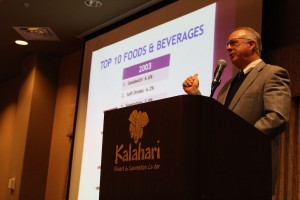SANDUSKY, Ohio — The 2014 gathering of the Ohio Produce Growers and Marketers Association got underway with a strong reminder about the importance of keeping up with an ever-changing consumer.
“For all of us to be successful in this industry, we need to figure out what customer behaviors are and where they’re going,” said Reggie Griffin, keynote speaker and past corporate vice president for Kroger’s produce and floral merchandising.
Griffin, who now works for his own marketing firm, Reggie Griffin Strategies, said understanding customer behavior is critical to a successful food business.
The trouble is, consumers change so fast, even faster than food retailers and marketers change.
Specific changes
A big consumer change the past few years has been the reliance upon social media and digital communications, especially among the millennial generation (generally born 1980-2000).
While it is no surprise many consumers now use Facebook and Twitter for food-related information, they’re also turning to newer forms, like Pinterest, to post pictures and information of food.
Griffin said more than half of Pinterest — an online gallery where people post pictures of their favorite things and links — consists of food-related images. And, about 30 percent of people who see those images, go out and buy those things.

His consulting work focuses on understanding the “ultimate customer,” the person who actually consumes the product that is purchased.
Today’s consumer
In three words, he said today’s ultimate customer is “confused, connected, and in control.”
The customer is “confused” because of changes in the economy, the government, his or her own situation and everything that is unpredictable.
The customer is “connected” because of today’s instant, fingertip information. Nothing is hidden anymore and there is an extreme demand for transparency and product traceability.
Lastly, the customer is “in control,” because ultimately the decision of what and where to buy lies with the customer. Griffin said the truth is that the customer is not always right, but because the customer is the buyer, they are always in control.
Other speakers
The produce congress featured educational sessions and industry updates throughout the day.
Karl Kolb, project manager for the Ohio Produce Marketing Agreement, said the state’s new food safety certification program is being reviewed by the Ohio Department of Agriculture, and will likely be complete by the end of January.
So far, only three farms have become members of the new organization — referred to as OPMA — but Kolb expects a substantial increase in members once the ODA review is complete.
The Ohio plan is billed as a way of ensuring Ohio growers have a food safety certification program that matches the needs of Ohio growers, and is being designed by farmer-members.
In his closing remarks, Griffin weighed in on the matter, saying that produce growers are smart and capable of setting their own standards. And if they don’t, the federal government will set the standards for them.
“I think controlling your own destiny is the way to go,” Griffin said.
Political points
U.S. Sen. Sherrod Brown, D-Ohio, addressed the group by pre-recorded video. Brown serves on the Senate Ag Committee and is one of the congressional leaders currently conferencing a new farm bill.
He said legislation he introduced is being considered in the farm bill that would support local farms, local foods and jobs.
“Whether it’s investment in food processing equipment or developing a business plan, I’m committed to growing our state’s specialty crop industry,” Brown said.
Ohio Agriculture Director David Daniels spoke about the strong heritage of Ohio agriculture and said the state is in doing a good job of attracting new agribusiness.
The state has recognized its 100-year-old century farms since 1994, but this year began recognizing 200-year-old bicentennial farms, as well, Daniels said.
He said he’s talked to business leaders in other states who are excited about the opportunities in Ohio and locating to this state.
Daniels said Sen. Brown is right that every seven jobs in Ohio is tied to agriculture, amounting to a $107 billion industry.
But, Daniels said the way things are headed, he’s optimistic the numbers will soon get even better.
“We hope that it’s one in every five (jobs) here before too long,” he said.
(For more coverage from the meeting and the OPMA, visit us online and in next week’s print edition.)











